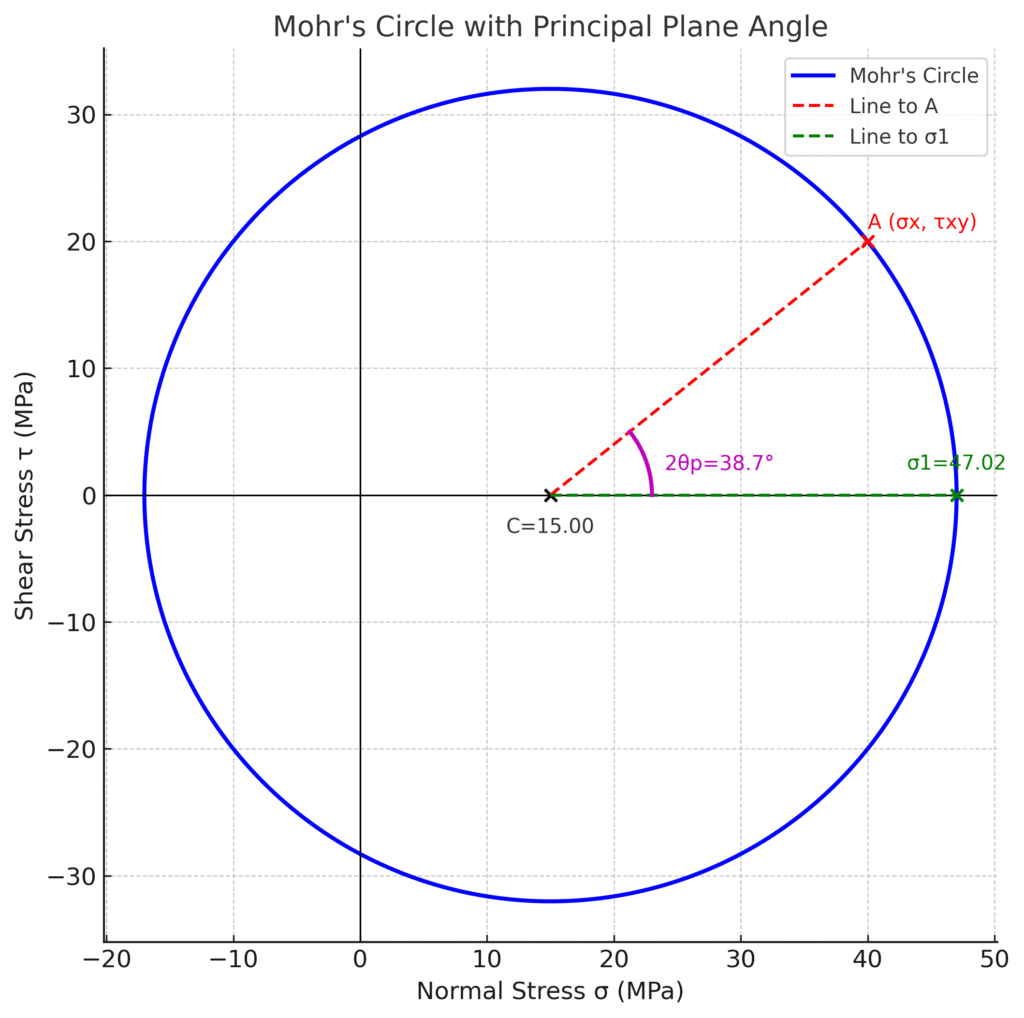What is Mohr’s Circle?
Mohr’s Circle is a graphical method in mechanics to find:
- Principal stresses (σ₁, σ₂)
- Maximum shear stress (τmax)
- Stress transformation at any angle
It converts complex 2D stress problems into a circle diagram for easy visualization.
How to Construct Mohr’s Circle
Suppose a material element has the following data:
- Normal stress in x-direction = σx
- Normal stress in y-direction = σy
- Shear stress = τxy
Plot the coordinates (σ, τ):
- Point A = (σx, τxy)
- Point B = (σy, –τxy)
Find the center of the circle (C)= C=σx+σy /2
Radius (R)= ((σx-σy/2)2+(τxy)2 )1/2
Principal stresses (σ₁, σ₂): C ± R
Maximum shear stress: τmax=R
Principle plane angle =θₚ = 1/2* tan-1(2τₓᵧ /(σₓ − σᵧ))
Example
σx = 40.0 MPa, σy = –10.0 MPa, τxy = 20.0 MPa
Center (C)= C=σx+σy /2 = (40-10)/2 =15 MPa
Radius (R)= ((σx-σy/2)2+(τxy)2 )1/2 = (((40+10)/2)2+(20)2 )1/2 =32.016MPa
Principal stresses:
σ₁ = C + R = 15 + 32.016=48.016 MPa
σ2 = C – R = 15 – 32.016= -17.016 MPa
Maximum shear stress τmax=R=32.016 MPa
Principle plane angle = θₚ = 1/2*tan-1(2τₓᵧ /(σₓ − σᵧ))=1/2*tan-1(2*20/(40+10) =19.33 degree

Mohr’s Circle Calculator
The Mohr’s Circle Calculator is a powerful and user-friendly tool designed for civil, structural, and mechanical engineers who need quick and accurate stress analysis. By entering the in-plane normal stresses (σₓ, σᵧ) and shear stress (τₓᵧ), you can instantly calculate principal stresses, maximum shear stress, rotation angles, and Von Mises stress. The calculator also generates a clear Mohr’s Circle diagram, making it easy to visualize stress transformations and understand material behavior under different loading conditions. Whether you’re working on structural design, academic projects, or professional engineering tasks, this interactive calculator streamlines complex calculations and enhances your workflow.
Input σₓ, σᵧ, and τₓᵧ to compute and visualize Principal Stresses (σ₁, σ₂)Maximum Shear Stress (τₘₐₓ), Rotation Angle (θₚ) and Von Mises Stress (σVM) on Mohr’s Circle.
Formulas
- σmean = (σₓ + σᵧ) / 2
- R = √(((σₓ − σᵧ)/2)² + τₓᵧ²)
- σ₁,₂ = σmean ± R
- τₘₐₓ = R
- θₚ = ½·arctan(2τₓᵧ/( σₓ − σᵧ))
- σVM = √(σₓ² − σₓσᵧ + σᵧ² + 3τₓᵧ²)

Leave a Reply